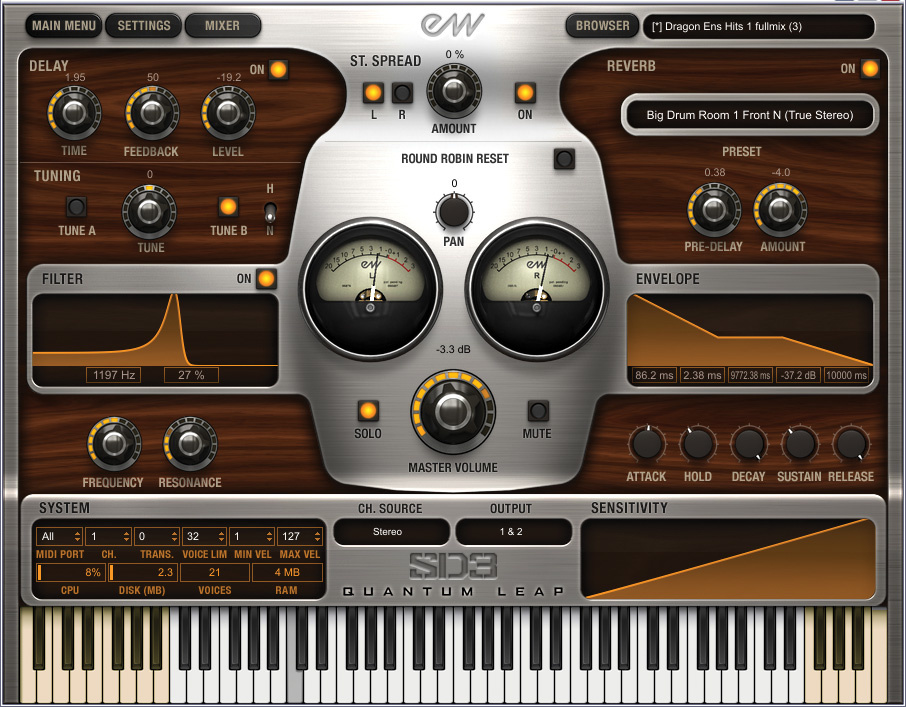
For the first time, users will have more control over the sounds offered in the collection along with the ability to load even more instruments than ever before. All of the instruments and ensembles featured in the collection were sampled extensively as a means of preserving the true character and expression of each instrument. Musicians will find that RA has an amazing sound quality and they'll marvel at the articulation of each instrument which has a wide range that goes from controlled to expressive. Quantum Leap RA provides composers with access to a variety of rare and unique instruments from Africa, Europe, India, the Americas and Australia, the Far East, and the Middle East and Turkish Empires. The instruments featured in the PLAY Editions are newly-programmed for PLAY from the original recordings.Stereo image editing is now possible using channel sourcing.Hi-fidelity one pole filter for natural cross-fades.Improved sound quality with high-resolution audio engine.State-of-the-art convolution reverb with pre-delay.Offers improved articulation window and controls.Intelligent performance section including portamento, repetition, legato.

64-bit (for 32-bit compatibility, please use PLAY 4).In addition to PLAY's intuitive custom interface, Quantum Leap RA - PLAY Edition includes many other features, such as:

Quantum Leap - RA - PLAY Edition, THE DEFINITIVE RARE AND ETHNIC VIRTUAL INSTRUMENT now available with the advanced featuers of PLAY Please read the documentation for more information and support details. Close, Mid, Main, Surround and finally Surround Vintage.For the benefit of all, EW/QL user Jonathan Loving has created a Sound Set for using Quantum Leap RA within Sibelius 5 and Sibelius 6.
#Eastwest quantum leap ram mod
Violin section: Using the same patch and performance this time we're using expression (CC#11) to control the loudness and timbre throughout, and mod wheel (CC#1) to control vibrato depth on held notes.Ĭello divisi: Here we're playing a part on a round robin Cello divisi patch first left (A) then right (B) perspective.įull strings: This part is played using the full string patch, each time we hear a different set of mics. In the first example playing tempo affects use of bow change samples, and velocity affects use of slur or portamento. Violin section: A single melody line played using the bow change, slur and portamento patch from the legato powerful system folder. However, if you produce soundtrack music professionally and/or seriously, you'll be used to that. In practice, these can be useful for adding part clarity as well as producing traditional divisi (split) parts.Īll told, Hollywood Strings is an incredibly impressive but demanding instrument, both in terms of system resources and your own mental faculties. However, EastWest have included full folders of 'divisi'-style patches captured concurrently using close mics to the left and right of each section. With skill, further subtleties can be achieved using finger position (FP) patches and, in some instances, MIDI CCs (portamento speed).įinally, it's worth saying that Hollywood Strings is purely section-based, so there are no solo instruments. Next, some legato patches combine articulations and use a tempo-detection script to switch between them. For legato patches, velocity affects transition speed rather than volume, so playing harder means a quicker transition. Importantly, it's very consistent, but there are also real subtleties worth mentioning. Onto the sound, and, unsurprisingly, it's excellent. With such large sample sets to load, you'll want to pick the right one first time. As far as patch selection is concerned, the key to success is in learning their abbreviations (BC for 'bow change', for example). Given the potentially stressful CPU and RAM demands, it's a relief that some patches offer a 'lite' version too. For vibrato and loudness (including the accompanying timbre), you can morph between playing intensities using MIDI CCs. However, one of the biggest features is actually quite subtle: sample crossfading. A number of violin, viola and cello long-bowed patches include control of string choice via finger position, so you can take advantage of the mellower bridge sound, for example.įurther articulations include bow change, up bow, down bow, played effects (tremolo and trill) and a number of prerecorded and playable runs in patch form. One interesting new feature is finger position.

The five options are main pickup (Decca Tree), mid pickup (auditorium front row), close pickup, surround (rear of recording space) and vintage ribbon surround (the surround options are mutually exclusive). Much like EastWest's Symphonic Orchestra, Hollywood Strings presents the instruments as multi-mic setups, enabling you to roll your own blend.


 0 kommentar(er)
0 kommentar(er)
